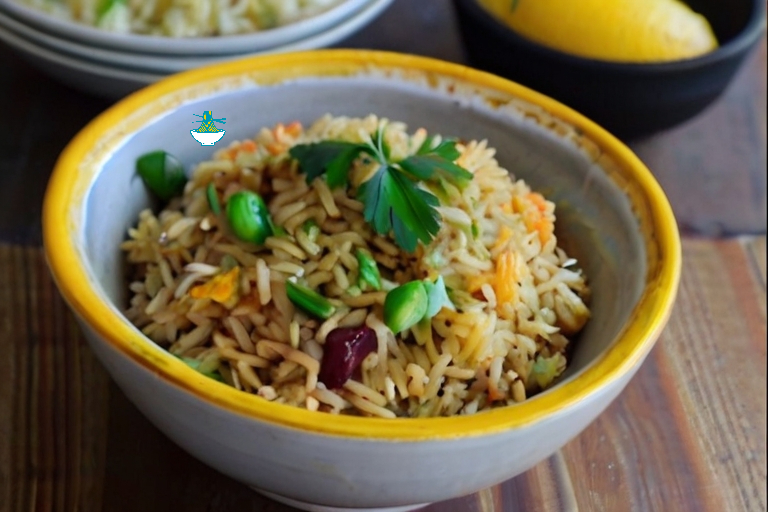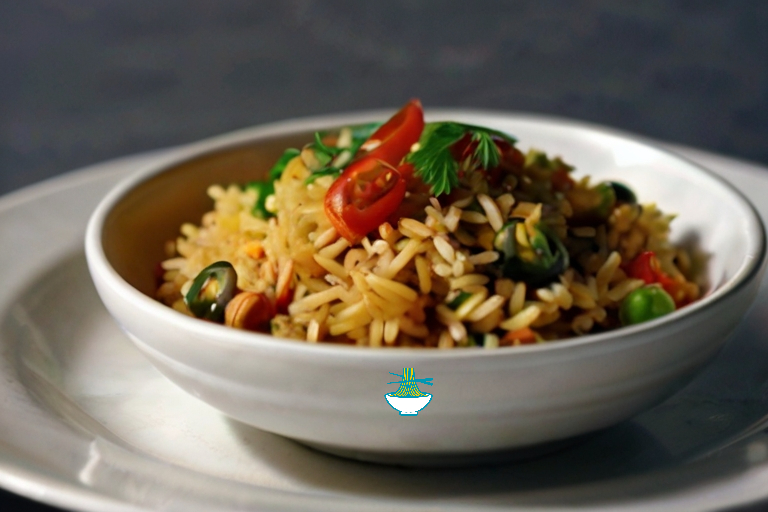Embark on a flavorful journey to the sun-kissed shores of Cyprus with its signature dish, Cyprus Pilafi. This traditional Cypriot rice dish is a tantalizing blend of aromatic spices, succulent meats, and fragrant herbs, all cooked to perfection. Each grain of rice is infused with the essence of the Mediterranean, offering a taste that is both comforting and exotic.

In this culinary delight, tender pieces of lamb or chicken are gently simmered with onions, garlic, and a medley of spices, creating a rich and hearty base. The addition of locally grown vegetables such as carrots, peas, and tomatoes adds vibrant colors and a burst of freshness to the dish.
What truly sets Cyprus Pilafi apart is its cooking method. The rice is carefully cooked in a flavorful broth until it reaches a fluffy consistency, absorbing all the savory flavors of the ingredients. The result is a dish that is not only delicious but also deeply satisfying.
Whether enjoyed as a comforting family meal or served as a centerpiece at festive gatherings, Cyprus Pilafi embodies the warmth and hospitality of Cypriot cuisine. Its irresistible aroma and mouthwatering taste will transport you to the shores of the Mediterranean with every savory bite.

Here's a traditional recipe for Cyprus Pilafi, a delightful Cypriot rice pilaf:
Ingredients:
- 2 cups long-grain rice (such as basmati)
- 2 tablespoons olive oil
- 1 large onion, finely chopped
- 2 cloves garlic, minced
- 500g lamb or chicken, cut into bite-sized pieces
- 1 teaspoon ground cumin
- 1 teaspoon ground coriander
- 1 teaspoon ground cinnamon
- 1 teaspoon dried oregano
- Salt and pepper to taste
- 3 cups chicken or vegetable broth
- 1 cup frozen peas
- 1 large carrot, diced
- 1 large tomato, diced
- Fresh parsley, chopped (for garnish)
Instructions:
1- Rinse the rice under cold water until the water runs clear. Drain and set aside.
2- In a large pot or Dutch oven, heat the olive oil over medium heat. Add the chopped onion and minced garlic, and sauté until softened and translucent, about 3-4 minutes.
3- Add the lamb or chicken pieces to the pot and cook until browned on all sides, about 5-6 minutes.
4- Stir in the ground cumin, ground coriander, ground cinnamon, dried oregano, salt, and pepper. Cook for another 1-2 minutes to toast the spices and release their flavors.
5- Pour in the chicken or vegetable broth and bring to a simmer.
6- Add the rinsed rice to the pot, stirring well to combine with the other ingredients.
7- Reduce the heat to low, cover the pot, and let the rice simmer for about 15-20 minutes, or until the rice is cooked and the liquid has been absorbed. Check the rice occasionally and add more broth or water if needed.
8- Once the rice is cooked, stir in the frozen peas, diced carrot, and diced tomato. Cover the pot again and let it cook for another 5-7 minutes, or until the vegetables are tender.
9- Remove the pot from the heat and let it sit, covered, for a few minutes to allow the flavors to meld together.
10- Fluff the rice pilaf with a fork and transfer it to a serving dish. Garnish with freshly chopped parsley before serving.
Enjoy your delicious Cyprus Pilafi as a main course or as a side dish alongside grilled meats or fish.
Nutritional Values:
Here's an approximate breakdown of the nutritional values for the main ingredients used in Cyprus Pilafi:
Long-grain rice (2 cups, uncooked):
- Calories: 440 kcal
- Carbohydrates: 96g
- Protein: 8g
- Fat: 1g
- Fiber: 2g
benefits:
- Provides energy due to its high carbohydrate content.
- Contains some protein for muscle repair and growth.
- Rich in vitamins and minerals like B vitamins, iron, and magnesium, supporting overall health.
Olive oil (2 tablespoons):
- Calories: 238 kcal
- Fat: 27g
- Saturated fat: 4g
- Monounsaturated fat: 18g
- Polyunsaturated fat: 3g
benefits:
- Healthy source of monounsaturated fats, beneficial for heart health.
- Contains antioxidants that protect against inflammation and oxidative stress.
- Helps in the absorption of fat-soluble vitamins like A, D, E, and K.
Onion (1 large):
- Calories: 60 kcal
- Carbohydrates: 14g
- Protein: 2g
- Fiber: 2g
benefits:
- Rich in antioxidants, particularly quercetin, which may have anti-inflammatory and anti-cancer properties.
- Contains prebiotic fibers that promote gut health and digestion.
- Provides vitamins C and B6, and potassium, supporting immune function and nerve health.
Garlic (2 cloves):
- Calories: 10 kcal
- Carbohydrates: 2g
- Protein: 0.5g
benefits:
- Known for its antimicrobial properties, aiding in fighting infections.
- Contains allicin, a compound with potential cardiovascular benefits, including lowering blood pressure and cholesterol.
- May have anti-inflammatory effects and support immune function.
Lamb or chicken (500g):
- (Nutritional values can vary depending on the cut and preparation method. Below are approximate values for lean lamb or chicken breast.)
Lamb:
- Calories: 970 kcal
- Protein: 108g
- Fat: 58g
Chicken:
- Calories: 670 kcal
- Protein: 120g
- Fat: 18g
benefits: Lamb or chicken:
- Excellent source of high-quality protein, essential for muscle repair and growth.
- Rich in vitamins and minerals such as iron, zinc, and B vitamins, supporting overall health.
- Provides essential amino acids necessary for various bodily functions.
Ground cumin, ground coriander, ground cinnamon, dried oregano (1 teaspoon each):
- Negligible calories, usually less than 5 kcal total
- These spices contribute minimal calories but add flavor to the dish.
benefits:
- These spices contain antioxidants that help neutralize free radicals and reduce inflammation.
- Can aid in digestion and improve gut health.
- Contribute to the unique flavor profile of the dish without adding significant calories.
Salt and pepper (to taste):
- Negligible calories
benefits:
- Salt helps regulate fluid balance and nerve function in the body.
- Pepper contains piperine, which may enhance the absorption of certain nutrients and have antioxidant properties.
Chicken or vegetable broth (3 cups):
- Calories: 45-60 kcal (depending on whether it's homemade or store-bought)
- Protein: 3-4g
- Carbohydrates: 3-4g
benefits:
- Provides hydration and flavor to the dish without adding many calories.
- Contains essential nutrients like protein, vitamins, and minerals, depending on the ingredients used.
Frozen peas (1 cup):
- Calories: 60 kcal
- Carbohydrates: 11g
- Protein: 4g
- Fiber: 4g
benefits:
- Excellent source of plant-based protein and dietary fiber.
- Rich in vitamins A, C, and K, as well as folate and iron.
Carrot (1 large):
- Calories: 30 kcal
- Carbohydrates: 7g
- Protein: 1g
- Fiber: 3g
benefits:
- High in beta-carotene, a precursor to vitamin A, important for vision, skin health, and immune function.
- Provides fiber, supporting digestive health and promoting feelings of fullness.
- Contains antioxidants like vitamin C, aiding in immune support and reducing inflammation.
Tomato (1 large):
- Calories: 30 kcal
- Carbohydrates: 7g
- Protein: 2g
- Fiber: 2g
benefits:
- Rich in lycopene, an antioxidant associated with reduced risk of certain cancers and heart disease.
- Contains vitamins C and K, as well as potassium, supporting immune function, bone health, and blood pressure regulation.
- Provides fiber, aiding in digestion and promoting satiety.
These values are approximate and can vary based on factors such as brand, cooking methods, and specific ingredients used. It's always a good idea to check the nutritional information on product packaging for precise values.


Comments